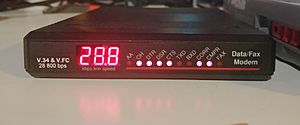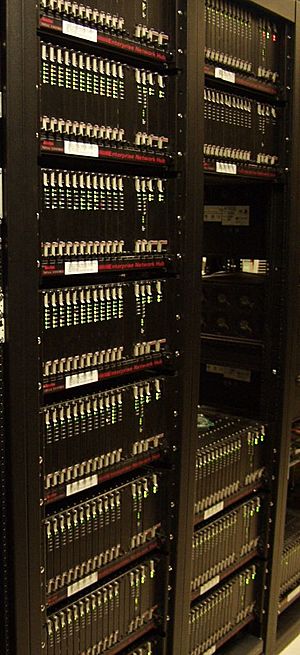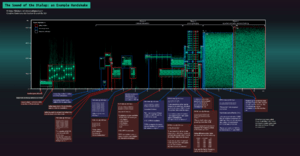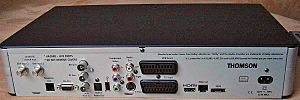Dial-up Internet access facts for kids

Dial-up Internet access was a way to connect to the internet using a regular telephone line. Imagine your phone line, but instead of talking, it was used to send and receive internet data! It worked by dialing a special telephone number to connect to an Internet service provider (ISP). This connection used a device called a modem. Modems turned computer data into sounds that could travel over phone lines, and then turned those sounds back into data for the computer.
Contents
How Dial-Up Started
In 1979, two smart people from Duke University, Tom Truscott and Jim Ellis, created something like an early internet called Usenet. It used dial-up to send information through phone modems.
Dial-up internet became available in the 1980s through places like universities. In 1989, the BBC in the UK started offering internet access. Then, in 1992, companies like Pipex in the UK and Sprint in the US began selling dial-up internet to everyone.
After faster internet, called broadband, came out in the late 1990s, dial-up became less popular. But it's still used in some places today, especially in rural or faraway areas where faster internet is not available or costs too much.
Modems and Their Sounds
Back then, phone lines could only carry one signal at a time. This meant if you were using dial-up internet, you couldn't use your phone to talk!
A modem was key to dial-up. It took digital information from your computer and changed it into audio signals (sounds). It then sent these sounds over the phone line to another modem at the ISP. That modem would then change the sounds back into digital information for the internet.
You might remember the unique, often loud, sounds modems made when connecting. This "handshake" was the modems talking to each other to set up the connection.
The internet speed with dial-up was quite slow, often around 21.6 kbit/s (kilobits per second) or even less. Things like a noisy phone line could make it even slower.
Where Dial-Up Was Available
Dial-up connections didn't need much special equipment beyond a phone line and modems. Because phone lines were almost everywhere, dial-up was often the only internet choice for people in rural or remote places. In these areas, it's expensive to build the faster internet networks.
Over time, fewer people used dial-up. In 2008, about 10% of adults in the US still used it. By 2013, that number dropped to only 3%. People often kept dial-up because faster internet was too expensive for them. By 2017, it was estimated that only 0.3% of Americans still used dial-up.
Faster Internet Takes Over
Faster internet connections, known as broadband, started to replace dial-up. These include cable, digital subscriber line (DSL), wireless broadband, and satellite internet.
Broadband connections are much faster, usually 700 kbit/s or more. They are also "always on," meaning you don't have to connect and disconnect every time you want to use the internet. Plus, with broadband, you can use your phone line for calls while you're online, which was a big improvement!
Even though most people now have broadband, some rural areas still don't have access to high-speed internet. This is often because there aren't enough people to make it profitable for companies to build the expensive networks there.
Dial-up usage has dropped a lot. In 2000, about 34% of people in the US used dial-up. By 2013, it was only 3%. Newer computer programs and operating systems need a lot of internet speed. They often download big updates in the background, which can make dial-up connections very slow. Many new websites also expect fast internet, so they might not work well with dial-up.
Even with the big drop in use, dial-up internet still exists in some rural areas and in many developing countries. However, wireless and satellite broadband are starting to bring faster connections to these places too. For example, BT, a big phone company in the UK, stopped offering dial-up service in 2013.
How Fast Was Dial-Up?
Most dial-up modems could theoretically reach a maximum speed of 56 kbit/s. But in real life, speeds were usually between 40 and 50 kbit/s. Things like noise on the phone line or the quality of the modem could make the connection even slower. Sometimes, in very noisy areas, speeds could drop to 20 kbit/s or less.
Dial-up connections also had high latency. This means there was a delay between when you sent a command (like clicking a link) and when the internet responded. High latency made things like video calls and online gaming very difficult or impossible. Many modern internet videos and music also won't work well at dial-up speeds.
Older video games from the 1990s and early 2000s, like EverQuest or Quake 3: Arena, were designed to work with slower dial-up speeds. Early game consoles like the Dreamcast and PlayStation 2 also supported dial-up. But most computer and video games made after 2006 need a faster broadband connection.
Making Dial-Up Faster with Compression
Some technologies helped modems send data faster than the actual line speed by using data compression. This means the modem would squeeze the data into a smaller size before sending it.
For example, a 53.3 kbit/s connection could sometimes send data as fast as 320 kbit/s if the data could be compressed a lot. But if you were sending files that were already compressed (like JPEG images or MP3 music), the speed wouldn't increase much.
Compression by Internet Companies
As dial-up became less popular, some internet companies tried to make it seem faster. They used special programs to compress things like images and text on websites before sending them over the phone line.
This made web pages load much faster. Text could load up to 20 times faster, and images could load several times faster. The downside was that pictures might look a bit blurry or less colorful because of the compression. But you could usually choose to see the full-quality images if you didn't mind waiting longer.
Dial-Up in Other Devices
Other devices, like some satellite receivers and digital video recorders (like TiVo), also used dial-up connections. They would dial a special number to download information, like TV show schedules, or to report what you watched. These devices didn't need a regular internet account; they just called the service provider directly.

Later, as broadband became common, these devices started using Ethernet cables to connect to a home internet router instead, which was much easier.
See also
 In Spanish: Conexión por línea conmutada para niños
In Spanish: Conexión por línea conmutada para niños
- Registered jack




